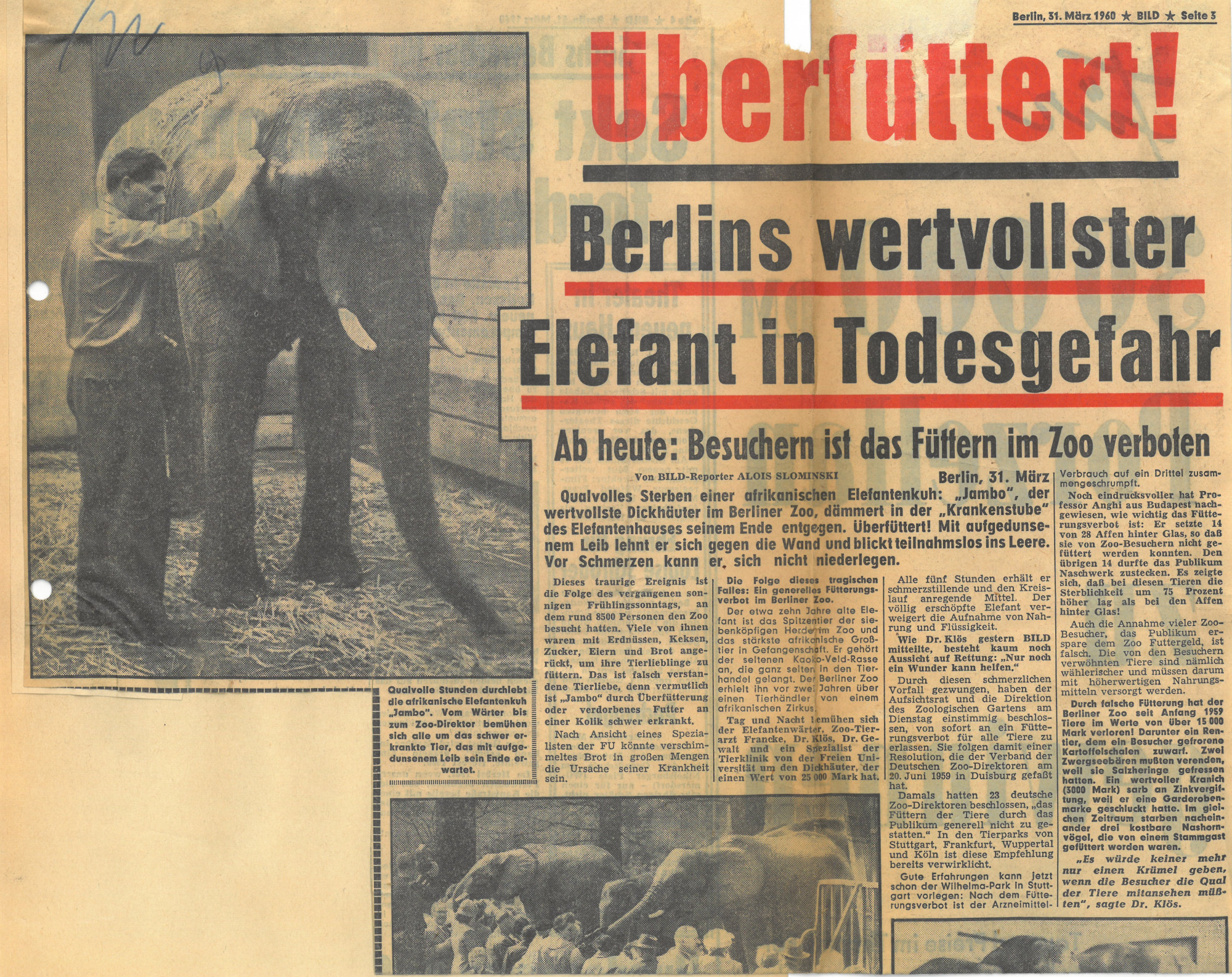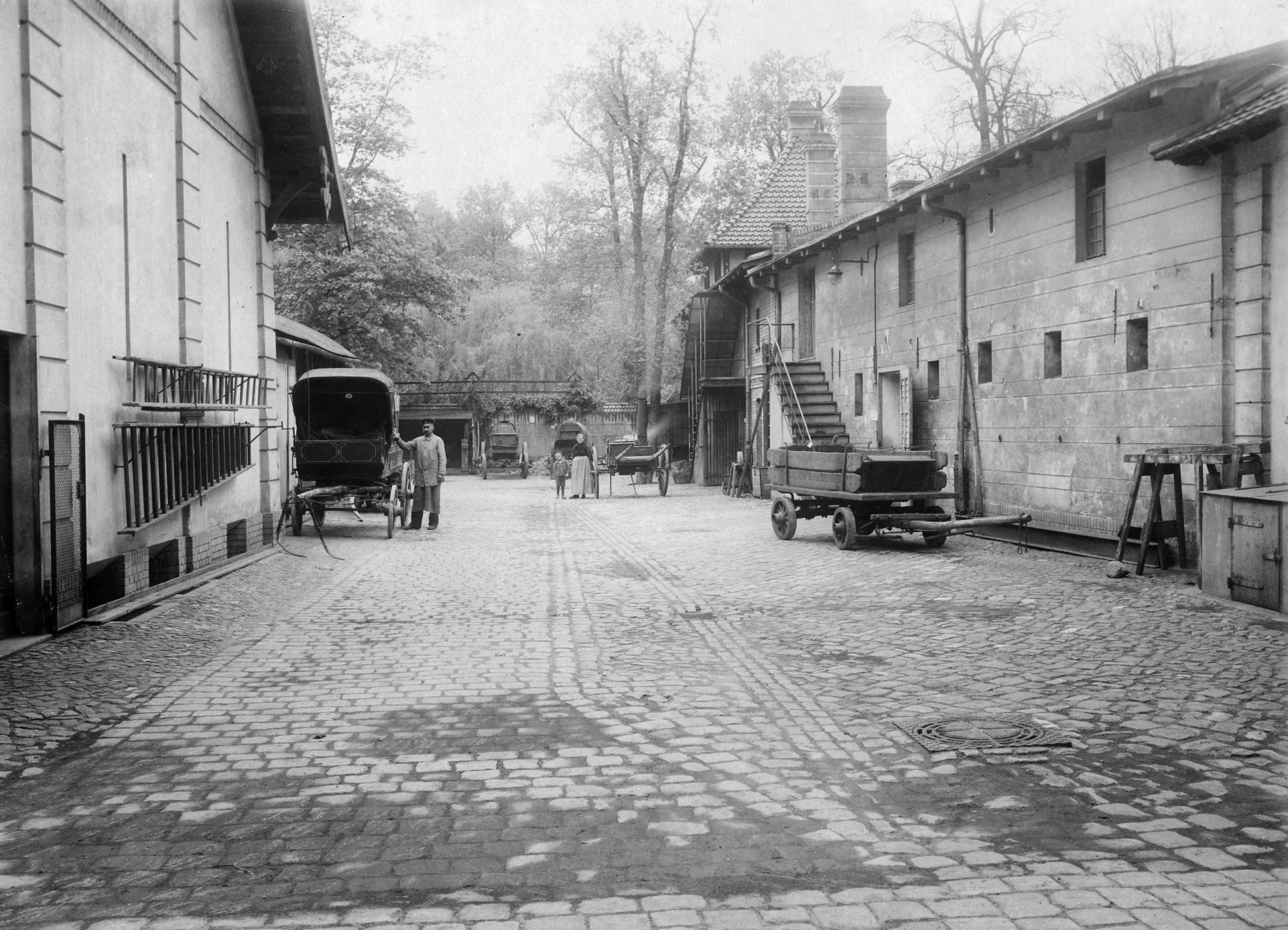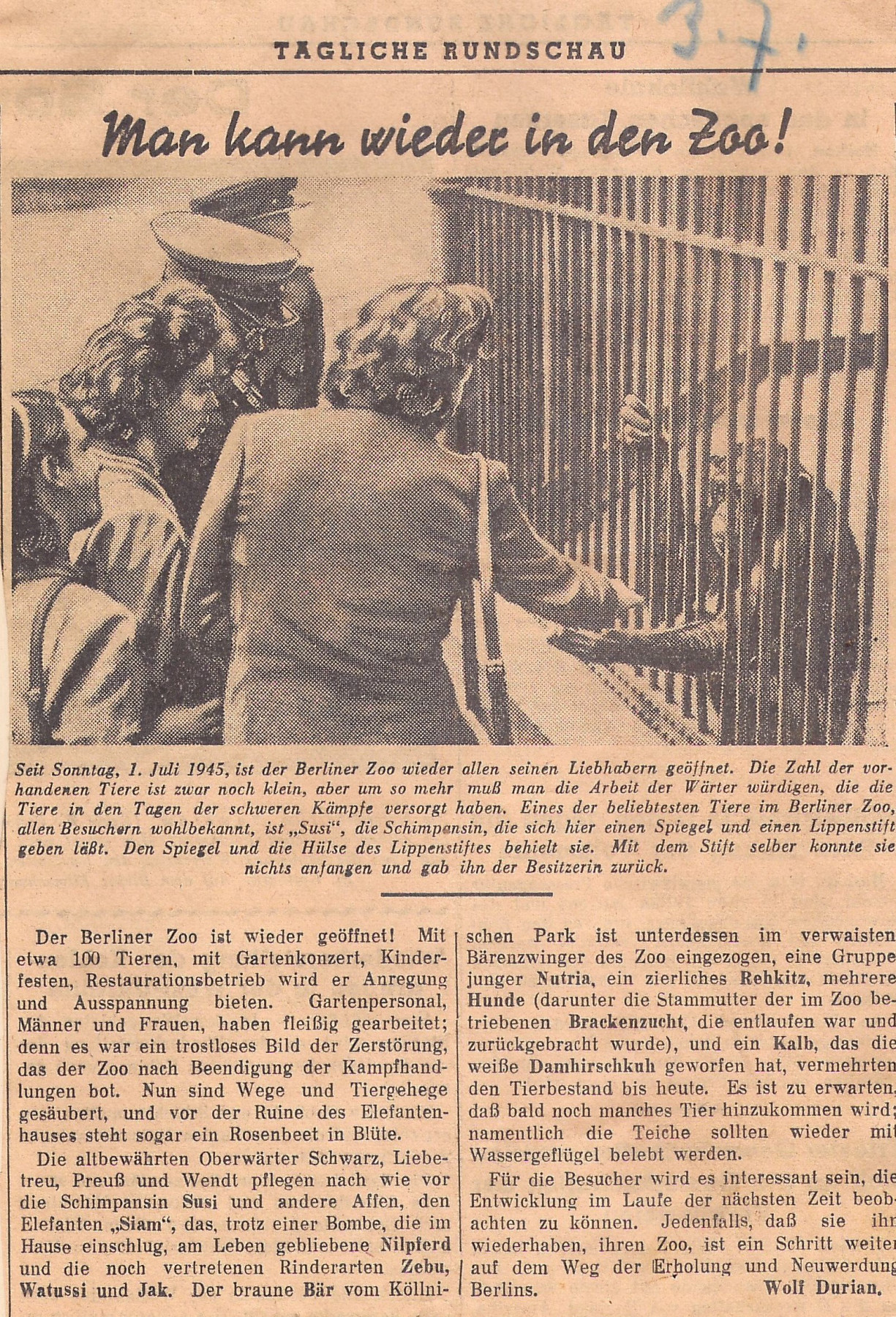
Headline of the Bild-Zeitung on the overfeeding problem, occasioned by “Jambo’s” illness, 31.03.1960.
While the zoo and the city of Berlin  struggled to provide food for their inhabitants in the 1940s, by the end of the 1950s, the situation had largely returned to normal again.1 In fact, in some ways it had gone in the opposite direction. The economic boom, the
struggled to provide food for their inhabitants in the 1940s, by the end of the 1950s, the situation had largely returned to normal again.1 In fact, in some ways it had gone in the opposite direction. The economic boom, the  ‘Wirtschaftswunder’ years meant visitors fed the animals at Berlin Zoo as much as they pleased – to the extent that in 1960, the African elephant “Jambo” fell ill after, or rather as a result of, being fed by zoo visitors.
‘Wirtschaftswunder’ years meant visitors fed the animals at Berlin Zoo as much as they pleased – to the extent that in 1960, the African elephant “Jambo” fell ill after, or rather as a result of, being fed by zoo visitors.
The elephant cow suffered severe peritonitis and a rupture in the small intestine caused by a blockage. After spending 14 days trying unsuccessfully to save “Jambo”, the zoo made the decision to put the animal down. The incident was not an isolated case, however. In previous years, elephants had  died due to incorrect or excessive feeding in the zoological gardens of Antwerp, Hamburg, Frankfurt, Stuttgart, and Gelsenkirchen. In Berlin in 1961 alone, a baboon, a spotted toucan, a valuable crane, and two deer died as a result of overfeeding.
died due to incorrect or excessive feeding in the zoological gardens of Antwerp, Hamburg, Frankfurt, Stuttgart, and Gelsenkirchen. In Berlin in 1961 alone, a baboon, a spotted toucan, a valuable crane, and two deer died as a result of overfeeding.
What followed was a controversial debate, both inside and outside zoos, about the proper feeding (and treatment) of zoo animals. The issue goes as far back as the founding of zoological gardens in the 19th century: What was even known at the time about the nutritional requirements of zoo animals?
Forms of Feeding and Nutritional Knowledge
From the 19th century onwards, zoos in Germany and elsewhere set up kitchens for the preparation of feed for their animals. These were run by feeding experts, often advised by veterinarians. The Unter den Linden Aquarium in Berlin employed a ‘Küchenmeister’, a chef, from the 1880s onwards, and Frankfurt Zoo set up its own feeding kitchen as early as 1875. However, these were still located outside the zoo grounds. Nowadays, the kitchens are usually integrated into the zoo’s service and maintenance area.

Berlin Zoo’s service and maintenance area around 1930, located at the edge of the zoo’s grounds. Among other things, feed for the animals was grown, stored, and prepared here. (AZGB. All rights reserved.)
Indeed, initially, zoological gardens knew little about the feeding habits of the different animal species. While it is true that menageries and zoos were able to draw on the knowledge of  farm animal husbandry, there were many
farm animal husbandry, there were many  more species in zoological gardens, and people did not always have access to
more species in zoological gardens, and people did not always have access to  information about the needs of the
information about the needs of the  imported animals. Veterinary historian Benjamin Lamp details this ignorance in his account of the development of medicine for zoo animals.2 The keeping and breeding of domestic and laboratory animals, which were mostly imported from colonial territories to living rooms, zoological institutes, and physiological laboratories throughout Europe in the 19th century was characterised by a similar lack of knowledge. Scientists as well as amateur researchers and enthusiasts attempted to acclimatise the animals, meaning they tried to keep them alive or breed them in new climatic conditions. Feeding was an essential and vital part of this, which can be seen in the numerous articles and discussions on the subject in (specialist) journals such as
imported animals. Veterinary historian Benjamin Lamp details this ignorance in his account of the development of medicine for zoo animals.2 The keeping and breeding of domestic and laboratory animals, which were mostly imported from colonial territories to living rooms, zoological institutes, and physiological laboratories throughout Europe in the 19th century was characterised by a similar lack of knowledge. Scientists as well as amateur researchers and enthusiasts attempted to acclimatise the animals, meaning they tried to keep them alive or breed them in new climatic conditions. Feeding was an essential and vital part of this, which can be seen in the numerous articles and discussions on the subject in (specialist) journals such as  “Der Zoologische Garten”. What we know today about the nutritional needs of laboratory animals, for instance, is the result of a lengthy process. The price of this knowledge, as the science historian Christian Reiß has shown, was steep, entailing many failed experiments.3
“Der Zoologische Garten”. What we know today about the nutritional needs of laboratory animals, for instance, is the result of a lengthy process. The price of this knowledge, as the science historian Christian Reiß has shown, was steep, entailing many failed experiments.3
In the 19th century, Europeans could often only guess at the natural feeding habits of wild animals that had never, or only occasionally, been seen in Europe. Furthermore, often providing the right foodstuffs was  logistically complicated and expensive. As such, they tried to keep them alive with substitute foodstuffs or feed mixtures. These substitutes were often based on social conventions, rather than the animal’s actual habits and preferences. In the end, most animals were given high-calorie feed rations, which, however, lacked important vitamins and minerals. Although veterinarians identified links between animal diseases such as rickets and the diets of domestic and zoo animals early on, until the 20th century, people acquired little sound scientific knowledge about the nutritional requirements of wild animals in captivity.4 In Frankfurt, even after the
logistically complicated and expensive. As such, they tried to keep them alive with substitute foodstuffs or feed mixtures. These substitutes were often based on social conventions, rather than the animal’s actual habits and preferences. In the end, most animals were given high-calorie feed rations, which, however, lacked important vitamins and minerals. Although veterinarians identified links between animal diseases such as rickets and the diets of domestic and zoo animals early on, until the 20th century, people acquired little sound scientific knowledge about the nutritional requirements of wild animals in captivity.4 In Frankfurt, even after the  Second World War, the chimpanzees’ menu included a “jam sandwich every day”, as well as “fried steak”.5 Incorrect feeding with foodstuffs that were too high in calories repeatedly led to health problems, especially in the larger animals.6
Second World War, the chimpanzees’ menu included a “jam sandwich every day”, as well as “fried steak”.5 Incorrect feeding with foodstuffs that were too high in calories repeatedly led to health problems, especially in the larger animals.6
Good Feeding, Bad Feeding?
Visitors to zoological gardens were a component of the system of feeding from the start. Public zoos across Germany had allowed zoogoers to feed the animals with their own food or feed purchased on the zoo grounds since their establishment. Feeding offered the visitors an opportunity for  direct contact with the animals. The phenomena of incorrect and excessive feeding were therefore a part of, and indeed a problem for, zoological gardens from the beginning. As early as 1872, the naturalist and writer Gustav Jäger remarked:
direct contact with the animals. The phenomena of incorrect and excessive feeding were therefore a part of, and indeed a problem for, zoological gardens from the beginning. As early as 1872, the naturalist and writer Gustav Jäger remarked:
“What amused me most was the persistence with which loaves and bread rolls were thrown to the seals, so that often a whole bucket of them could be skimmed off the pond in one day, and only a sign saying: ‘Seals eat fish and not bread’ was able to make Viennese children with their love of baked goods understand that there were no loaves and bread rolls floating on the waters of the Baltic and North Seas.”7
Dried bread in fact remained one of the most important foodstuffs in zoos until the First World War. As Benjamin Lamp explains, this was not least due to the fact that in the summer months, some of the zoo’s feed requirements were met by visitors, who often brought old bread with them.8 The field of veterinary medicine also addressed these problems from an early stage. In 1925, a vet noted in an article for the Tierärztliche Rundschau: “Lately it is mainly stomach and intestinal diseases that afflict the animals, but feeding-related damage due to being fed by zoo visitors is also a contributory factor here.” The animals would “often fall ill and unfortunately die from the large quantities they could not tolerate. We are powerless to do anything about the habits of the visitors to the zoo, who, incomprehensibly, often throw spoiled food into the cages just to attract the animals’ attention.”9
How and what visitors fed the animals depended not only on personal preferences, but also on the given political, economic, and social conditions. How much food the visitors themselves had at their disposal, in particular, played a role. Before the war, as  Katharina Heinroth recalled, “so many sweets and cakes were given to Berlin Zoo visitors’ favorite animals that we had many cases of intestinal illnesses”.10 In the time immediately after the war, by contrast, she wished the visitors would bring
Katharina Heinroth recalled, “so many sweets and cakes were given to Berlin Zoo visitors’ favorite animals that we had many cases of intestinal illnesses”.10 In the time immediately after the war, by contrast, she wished the visitors would bring  more food for the animals. During this period, such edible gifts for the zoo animals were often framed by the press as symbolic gestures of sharing.
more food for the animals. During this period, such edible gifts for the zoo animals were often framed by the press as symbolic gestures of sharing.

The Tägliche Rundschau presents feeding the animals as an act of sharing in the post-war zoo, 03.07.1946.
 Letters from zoo visitors also show that many felt feeding the animals was not only a practical necessity, but also a form of caring. While in the first
Letters from zoo visitors also show that many felt feeding the animals was not only a practical necessity, but also a form of caring. While in the first  postwar years feeding became an act of solidarity with the zoo and its animals, and may even have saved the lives of some animals, the
postwar years feeding became an act of solidarity with the zoo and its animals, and may even have saved the lives of some animals, the  dangers of overfeeding returned in full force in the 1950s.
dangers of overfeeding returned in full force in the 1950s.
- The zoo stopped growing vegetables on its grounds as early as 1950: “We have a lot of plans for the spring; the gardening should stop now, because the food supply situation has improved substantially for the people of Berlin and vegetables can now be bought at the markets again. We can now beautify our grounds again.” K. Heinroth to U. Bergman, 07.03.1950, AZGB N 4/12.↩
- Cf. Benjamin Lamp. Entwicklung der Zootiermedizin im deutschsprachigen Raum. Giessen: VVB Laufersweiler, 2009: 160. In addition, suitable food was not always available due to limited transportation options and a lack of cooling technology, making it necessary to get the animals accustomed to substitute foodstuffs.↩
- Christian Reiß. “Wie die Zoologie das Füttern lernte: Die Ernährung von Tieren in der Zoologie im 19. Jahrhundert”. Berichte zur Wissenschaftsgeschichte 35, no. 4 (2012): 286-299. https://doi.org/10.1002/bewi.201201586. Cf. also Mareike Vennen. Das Aquarium: Praktiken, Techniken und Medien der Wissensproduktion (1840-1910). Berlin: Wallstein, 2018.↩
- Cf., for instance, Moritz Friedrich Röll. “Die Knochenweiche (Rachitis)”. In Lehrbuch der Pathologie und Therapie der Hausthiere, Moritz Friedrich Röll (ed.), Wien: Braumüller, 1860: 85; Walter Butler Cheadle. Rickets: A System of Medicine, Thomas Clifford Allbutt (ed.), vol. 4, London: 1897: 108-146. On this, see also Lamp, 2009: 160.↩
- Cf. Christoph Scherpner. Von Bürgern für Bürger: 125 Jahre Zoologischer Garten Frankfurt am Main Frankfurt a.M.: Zoologischer Garten, 1983: 126.↩
- In elephants, excessive weight combined with unsuitable ground covering often results in pathological changes in the soles of the feet and nails. The obesity of breeding bulls also reduces the chances of successful reproduction. This situation gradually changed as veterinary medicine developed, and as the large emerging animal trading houses, such as Hagenbeck or Ruhe, acquired knowledge from animal trappers. Feeding thus began to be oriented more toward the needs of the animals and to take their natural eating habits into account.↩
- Gustav Jäger. Skizzen aus dem Thiergarten, Leipzig: Baensch, 1872: 242.↩
- Lamp, 2009: 161-162.↩
- E. Kallmann. “Die Krankheiten der Tiere im Zoologischen Garten in Berlin”. Tierärztliche Rundschau 28 (12.07.1925): 482-484.↩
- Daniel de Luce. “Lebensmittelkarte 5 im Berliner Zoo”. Tägliche Rundschau, 17.12.1946. For further examples of animals that fell ill or died in Berlin Zoo around 1930 as a result of overfeeding, see also “Feeding prohibited! Observations at the zoo”. Steglitzer Anzeiger, 24.07.1930.↩